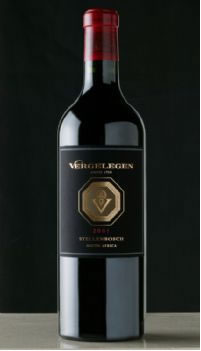

Vergelegen
“V” – an icon wine in the making?
By
 ' “V” is the validation
of Vergelegen’s striving to produce a wine that can stand on an equal footing
with the most prestigious wines in the world whilst at the same time
contributing to realizing Van der Stel’s original vision and the objective for
South Africa to be globally acknowledged as a producer of great wines.
“V” has been achieved by maximizing the synergies between the vineyards, the
winery, the vitality of the people who toil in both and the talents of a
dedicated and passionate winemaker.'
' “V” is the validation
of Vergelegen’s striving to produce a wine that can stand on an equal footing
with the most prestigious wines in the world whilst at the same time
contributing to realizing Van der Stel’s original vision and the objective for
South Africa to be globally acknowledged as a producer of great wines.
“V” has been achieved by maximizing the synergies between the vineyards, the
winery, the vitality of the people who toil in both and the talents of a
dedicated and passionate winemaker.'
If
you were fortunate enough to be able to afford to buy a case of Vergelegen’s
new wine, the “V”, then on opening the heaviest wooden slide top wine box to
come out of South Africa yet, you would have been greeted by a smartly printed
card with the above vinous proclamation. Indeed at between £55 and £58 pounds
a bottle, this makes Vergelegen’s wine the most expensive offering from South
Africa yet (if you don’t count the KWV Perold blends elusively retailing at
over $100 per bottle).
In
my recent columns for the Wineanorak, I have assessed several other top
“cultish” offerings from South Africa, the previously most expensive being
the Tete de Cuvee Pinot Noir 2001 from Bouchard Finlayson, retailing at £45 to
£48 pounds a bottle and with my final conclusion being, yes a very good wine
but perhaps a touch expensive. But where this new wine stands out is in the fact
that it is a Bordeaux styled blend constituting 91% Cabernet Sauvignon, 8%
Merlot and 1% Cabernet Franc. All the prestige wines reviewed have been produced
in minute quantities and the “V” is no exception, with only 25 x 225 litre
French Barriques produced for the 2001 vintage.
As
any wine affectionado will tell you, it is red Bordeaux and its top Cru Classé
wines that rule the world of commercially available fine wines, with top
Northern Rhone and Cote d’Or Burgundies seemingly far more nichey in
comparison perhaps due to the smaller quantities produced. French Bordeaux is
the confirmed international yardstick for fine wine quality. Even Vergelegen’s
winemaker Andre van Rensburg confirmed to me that the most impressive bottle of
wine he had ever drunk was a bottle of Chateau Petrus.
But
many readers may not even have heard of the “V” blend yet such is its
novelty and rarity. While there has been a certain amount of marketing
publicity, customers still confuse this new wine offering with Vergelegen’s
Estate red Bordeaux styled blend which retails for about £20 and is also highly
famed for winning the prestigious Chateau Pichon Longueville Comtesse de Lalande
Trophy for the Best Red Blend in the world two out of three years running, only
missing out on the clean sweep due to “cork taint problems” according to
Andre (for which Vergelegen has been embroiled in legal battles with their cork
supplier).
So
how has this new iconic blend been received by consumers and the general wine
trade? Well, the best starting point is always the SA wine bible, the John
Platter Wine Guide, in which the 2005 edition scores the first vintage of
“V” a straight 5 / 5 Stars. The 2001 they reckon was genuinely crafted to
grab the attention of the likes of
Robert Parker, The Wine Spectator and other influential judges. Despite the
single vineyard Cabernet Sauvignon fruit frame in the wine, the so called
“non-terroir” driven 2001 V hints that 5 to 10 years of aging may be
required to allow the 21 months of new French oak to integrate and allow the
hefty layers of fruit to unfold.
Over
A
deep crimson / purple colour, dense and viscous with thick long tears on the
glass. The nose is broad, powerful and fairly complex but still very youthful
and a touch two tone, showing spicy black currants and ripe plums and then
following with slightly stand apart but attractive expensive toasty, mocha,
vanilla and caramel new wood flavours. The wine is full bodied with silky, ripe,
fine grained tannins leading to a long, lingering aftertaste of black fruits and
chocolate, mocha
new oak. The alcohol of 15% is only really noticeable on the first taste and
then recedes as the fruit power takes over on the palate (or the senses get
dulled?) A lovely balanced acidity keeps the wine fresh and mouth watering as
the textured fruit layers stream over the palate. A dense, concentrated wine
that still retains a certain classical “ripe Bordeaux vintage made in a modern
style” type of appeal.
Score:
95-96+/100
So
there’s my snap shot view of my first tasting of the Vergelegen “V” 2001
for what it’s worth! I have to add quite strongly that while the wine is
drinkable now, just in the same way a bottle of 2001 or 2002 first growth claret
would also be, drinking it now would not do the wine or winemaker any justice. I
would agree with the general consensus and start drinking in perhaps 5 years
time when flavours will have melded and integrated and there’s a hint of
tertiary bottle development to add to the wine’s complexity.